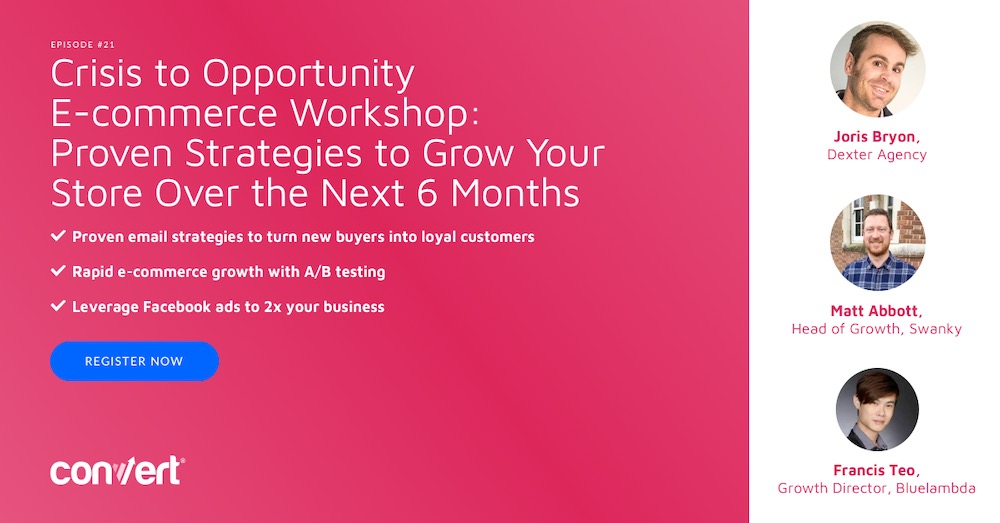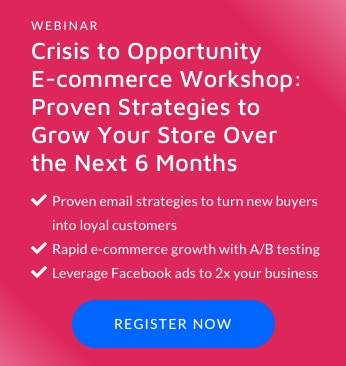Cart Abandonment 101: Why Visitors Don’t Convert at Checkout

Editors Note: Best practices change—so does this blog. This article was originally published February 22, 2017. It’s been updated for accuracy and usefulness February 9, 2018.
Cart abandonment is the most frustrating way to lose money.
You got a prospect to your site! You got them to browse! They selected an item (or many!) and threw it into their cart!
So why. didn’t. they. just. press. buy. already?
Allow us to demystify it for you.

Reasons for Cart abandonment
An abandoned cart is created when a customer adds items to the cart & then leaves the purchase. And according to Baymard, the average online cart abandonment rate is a whopping 69.23%.
There are multiple reasons, at different steps in the funnel, which could cause this to happen. Sometimes, the customer leaves for “life reasons.” They forgot they needed to go get groceries, or they’re just too busy to dig out their credit card right now.
How to follow up on #abandonedcarts to increase #sales w/ @tovishalck #ecommerce Click To TweetNow reasons like those we, as shop owners, have little control over. But there are plenty of reasons why a customer may bounce, that we could easily do something about.
Here are the top 13:
- High Shipping Costs
- Not ready to purchase, just comparing prices
- High Product Price
- Want to save products for later
- No clear shipping information available
- No Guest checkout option
- Complex or Insecure Checkout form
- Website takes too long to load
- Extra taxes surprise customers
- Few payment options
- Slow Shipping
- Too many offers
- Website crash
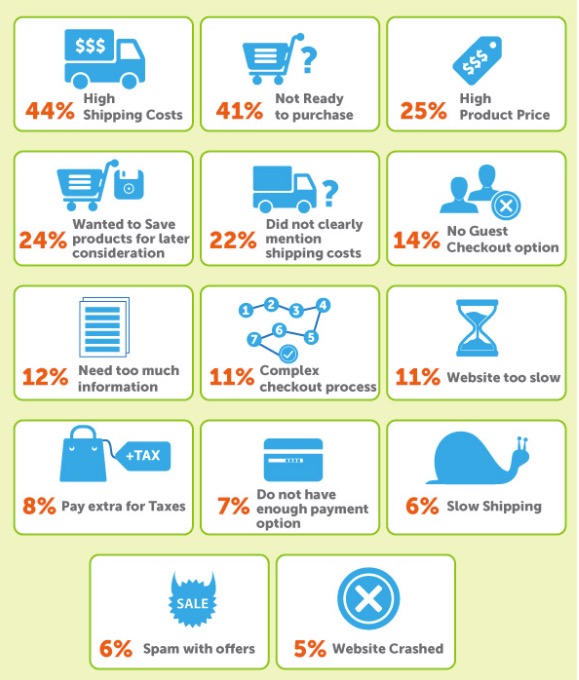
Reducing Cart Abandonment
There are solutions to tackle each of the problems mentioned above. The solutions mentioned below can reduce your cart abandonment rate & also help you recover some of the abandoned carts.
1. Checkout page not secure
This is actually applicable to your website, and not just checkout page. Your website starts making an impression on the customer right from the 1st page they land on. From there on, the impression either gets stronger or weaker depending on your website content & security practices.
The fact is that customers are uncomfortable about sharing their payment information on a checkout page. As per a recent study done by Baymard, 18% of users leave a purchase because they do not trust the merchant with their credit card information. That’s not a small number by any means.Your page has to be secured by practices like installing a SSL certificate, security seals and also it has to visually appear secure to your customer.
Your page has to be secured by practices like installing a SSL certificate, security seals and also it has to visually appear secure to your customer.
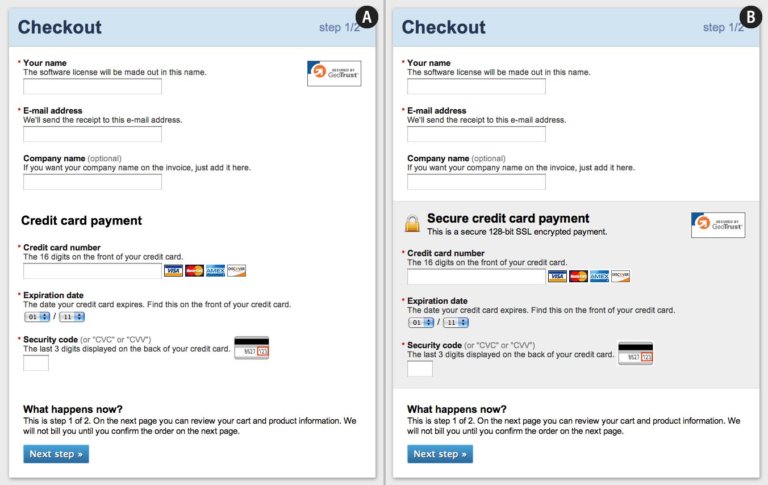
2. Customers are required to Create an Account before purchase
On many websites, merchants require you to create an account before you can proceed with placing an order. I know of some websites who don’t even let you view their products without giving an email address. Meh!
What happens here if the customer is not interested in creating an account with your website? If it is a new customer, the most likely outcome is that the customer will choose another alternative over yours. Simply because the customer is worried about their privacy as much as you are worried about your sales. You should always leave a window open for guest users to place an order. If they do need a product from you again, they will come back on your website if they are satisfied with the last purchase & service.
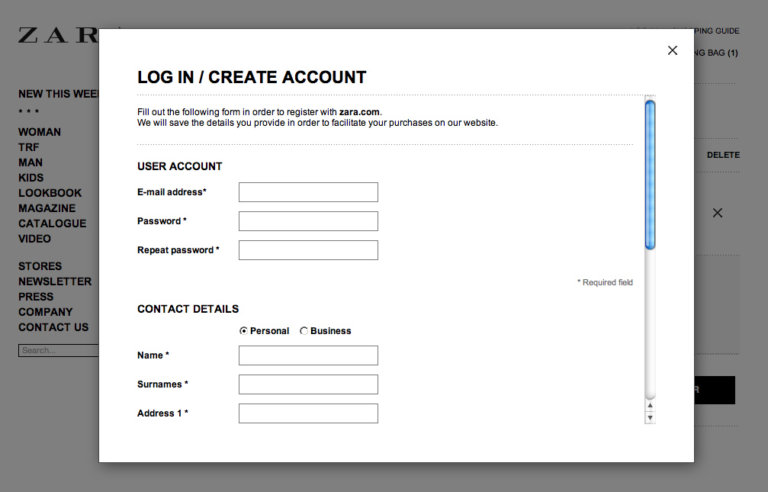
3. Not following-up with abandoned cart users
Capturing abandoned carts & following-up with them can give a tremendous boost to your conversion rates. Based on your eCommerce platform, there are various tools that allow you to capture abandoned carts. Some of them are even free.
One such freemium plugin available for WooCommerce is Abandoned Cart Lite. WooCommerce is the go-to Ecommerce plugin that is available for WordPress. It’s hugely popular & has gained a lot of traction in the last 3 years due to its freemium model & easy-to-get-started advantage.
The Abandoned Cart Lite plugin captures abandoned carts & allows you to follow-up on customers with different email campaigns. It allows you to recover 30% of the abandoned carts without spending a dime!
You should find a relevant tool or extension available for your platform & implement it on your website. Remember, it’s always easy to convert a customer who has tried to purchase from you once instead of converting an unknown customer.
4. Losing user information when form submitted throws an error
This often happens to us. Out of a set of fields that are needed to proceed, you miss out on a field or fill out a field wrongly. Now it’s a good practice to validate your customer’s information & show them appropriate messages if the information is not as desired.
This can so easily go the opposite way if the user information in those fields is not retained after showing the error. You stand the chance of losing this purchase just because your developer wanted to save his 2-3 minutes of time. This is the result you get:
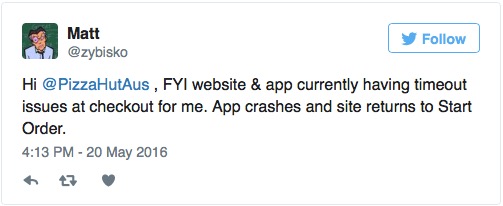
Here’s how to create persuasive forms to ensure your customers don’t abandon their carts.
5. Requiring unnecessary information
Depending on your business, ask only for as much information as is necessary for you to process an order. If you are selling digital goods, it might not make sense for you to ask for a Shipping Address. If you are selling bakery items, it might make sense for you to ask your customer as to what time they want the product delivered.If you dish out form after form (as is the case in many surveys),
Don't ignore abandoned carts on your #ecommerce #business, turn them into #sales Read Click To TweetIf you are selling digital goods, it might not make sense for you to ask for a Shipping Address. If you are selling bakery items, it might make sense for you to ask your customer as to what time they want the product delivered. If you dish out form after form (as is the case in many surveys),
If you dish out form after form (as is the case in many surveys), customer will either go away or only give you dummy information in order to speed up the purchase process. It makes more sense to only ask minimal information during purchase, and then probably ask them the details in their Edit Profile section.

6. Aggressive Upselling during checkout
During purchase, a buyer’s journey is self-driven. Upselling during checkout is the last thing you want to do!
The customer loses focus from the current purchase & either will get distracted by the upsell or will leave your website for the want of a smoother experience elsewhere.
You should pause your upselling & cross-selling during checkout. It’s even a good idea to completely hide your navigation menu.
7. Your website gives up on you
Having a website that functions without any interruptions seems like a very hard task, but it isn’t. This is what happens when people find it hard to purchase on your website:
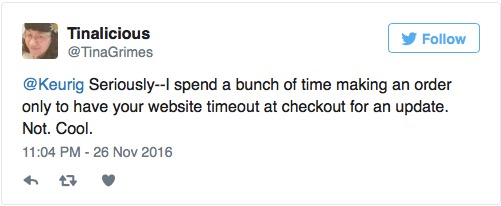
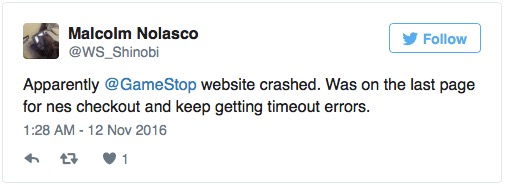
And the list goes on! It doesn’t matter if you are selling pizza or software or flowers. You’re losing revenue that was at your doorstep!
Reducing Cart Abandonment Matters More than Ever
Here’s what we’d recommended doing in the past, if you wanted to recapture leads that haven’t converted.
- Separate your checkout process into multiple steps, so that prospective customer submits their name and email first.
- If that same prospect doesn’t finish their checkout process, follow up with an automated email—reminding them that there are items in their cart waiting for them.
- Using Google remarketing, or facebook retargeting—show ads to anyone who made that far in the checkout process. They are, after all, your most qualified potential buyers.
Sounds like a solid way to follow up, no?
It was.
But, GDPR—or, General Data Protection Regulation—has been passed, and will be implemented in May of 2018. Along with it are a boatload of new rules as to how you can use personal data.
The fast facts:
Who does GDPR apply to?
Anyone who’s online store is based in the EU, or anyone who collects any data from any data subject in the EU. Even if that’s not you—it’s a good idea to start following GDPR rules for compliance. India, the United States, and just about everywhere else is working on similar legislation.
How does it affect Ecommerce?
For an in-depth explanation, head here. But what you really need to know is: to use personal data of any kind, you now need to ask for consent. Data subjects have to opt-in actively, and explicitly, for you to use or store their data in anyway. And the definition of personal data is, essentially, “anything that could identify a person”—and that includes a lot. Cookies, IP addresses, names, emails, etc.
Meaning: all the fun ways we used to retarget cart-abandoners—are getting a lot harder to legally implement. Email addresses require consent. Google and Facebook retargeting is likely to require consent. And getting consent to contact is just one more “ask” to throw in your visitors path pre-conversion.
So when someone gets to your checkout process, and bounces—well, they’ve more or less slipped through the marketing ether.
Which makes tightening up that checkout process, and reducing cart abandonment, matter more than ever.
Conclusion
Apart from these, there are some other reasons as well which contribute to cart abandonment like showing prices in a foreign currency, better pricing on other sites & so on.
Mitigating these can result in an overall higher conversion rate for your website. It also reduces your cart abandonment rate.
Cart abandonment is at a stage where we need to educate the business owner about it. If the business owner is unaware about it, then it’s our role, as service providers or consultants, to educate them about it & ask them to take appropriate actions.
Unless we do that, cart abandonment will continue to affect the conversion rate of a website. Check out this infographic on how to avoid cart abandonment

